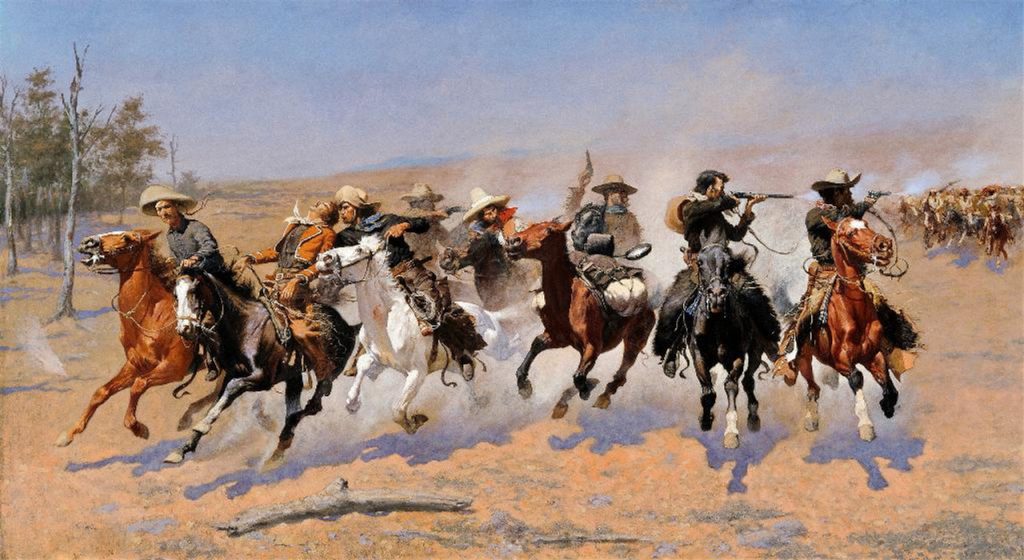Often called the Cowboy Artist, Frederic Remington was an American painter, sculptor, and illustrator. He was a prolific artist that massified the everyday lives of the people of the American West.
His artworks were mainly representations of nineteenth-century scenarios. In his artworks, Remington captured everything that surrounded war and interfered with soldiers’ lives. The illustrations were images of American Indians, cowboys, and the U.S. Cavalry.
Hailed as the most successful artist of the nineteenth century, Frederic Remington left behind a legacy worth remembering. Tap into this lucrative segment to learn about Frederic Remington’s art.
Table of Contents
A Dash for the Timber
In 1889, Frederic Remington painted A Dash for the Timber when the master was 28 years old. The artwork turned out to be an iconic masterpiece due to the various formative travels he took across the American west.
Famous artist Frederic Remington was even the favorite artist of President Roosevelt. However, A Dash for the Timber remains a prime example of vibrant Remington art. He enters into the open cognizance of American legend composition.
He found an audience for his figurative art reproductions that understood his narrative. The eager audience accepted his documentary-style images of how the wild-west was as a grim reality. His impact on his followers persuaded them to come into those lawless lands and ponder things that matter.
The Fall of the Cowboy
The Fall of the Cowboy brings to life an exceptional wreckage of the American West. It entails a picture of a society and its people fighting for longevity and survival in a quickly modernizing world.
The men are depicted in the middle of the land and are forced to cross a fence. The artwork is inspired by the “The Evolution of the Cow Puncher,” by Owen Wister, illustrated in Harper’s New Monthly Magazine issue of September 1895.
It is an iconic painting in American history that concentrates on the grim reality of the struggle faced by the common people. Not only did The Fall of the Cowboy gain critical acclaim, but it also narrated a part of society that needs to be conveyed, straight and stout.
Cold Range on the Field
It is a painting that shows a man on the American West frontier. He is riding a large, earthy-colored horse. The horse is a bit of a wild type and is in a constant jumping motion. The horse depicts an unusual, menacing look, suggesting that it doesn’t like to be ridden.
In the background lie other men with horses on a cattle drive. The color yellow is predominant to intensify the arid nature of the land. Remington emphasizes concrete ideas of independence, glory, and mastery over nature. The man in the front center of the painting is assumed to be a cowhand.
He wears a traditional garb of a cowhand, and the girth of his outfit is exactly similar to that of cowboys from the American West. His attire includes chaps, cowboy boots, and a canvas. There is no hat on his head because of the rudeness of the horse. There is a high chance that the hat may have been tumbled off by the horse.
Moreover, the man gives an impression of an accomplished rider. Being a professional, he grasps the reins with one hand and handily counterbalances it by placing his other hand in the air. On the contrary, his kindred hands have been used with some concentration. However, they are distant from him.
A Mexican Vaquero
Little did Remington know that his visit to Mexico in 1889 could be this beneficial to him later. Remington got a wealth of firsthand materials from this outing for his illustrations and paintings.
Remington went down the road and successfully created a Vaquero for this one. He is a Mexican Horseman, just like the other cowboys of the American West.
The valiant man sits astride his horse at an elevated position. The bodily positions are marked precisely, his head and the middle portion above the horizon. It is outlined with a vivid pale blue sky behind him.
By portraying the man with a direct gaze, the central figure, and his hand on the reins, the master makes the vaquero in contact with the observer. He even created a version of A Mexican Vaquero on a wood engraving.
The Bottom Line
For some, art is passion; for others, it is an obsession; for a very few, it is a weapon to bring the truth to the world. Remington was one such rebel artist. He used his talents to deliver a side of society that needed to come out in visuals that were hard to accept yet existed.
You can find out more about the paintings of Frederic Remington online. In addition, they provide you with apt information about the lifestyle of the American West, cowboys, and much more.
Alex is fascinated with “understanding” people. It’s actually what drives everything he does. He believes in a thoughtful exploration of how you shape your thoughts, experience of the world.

